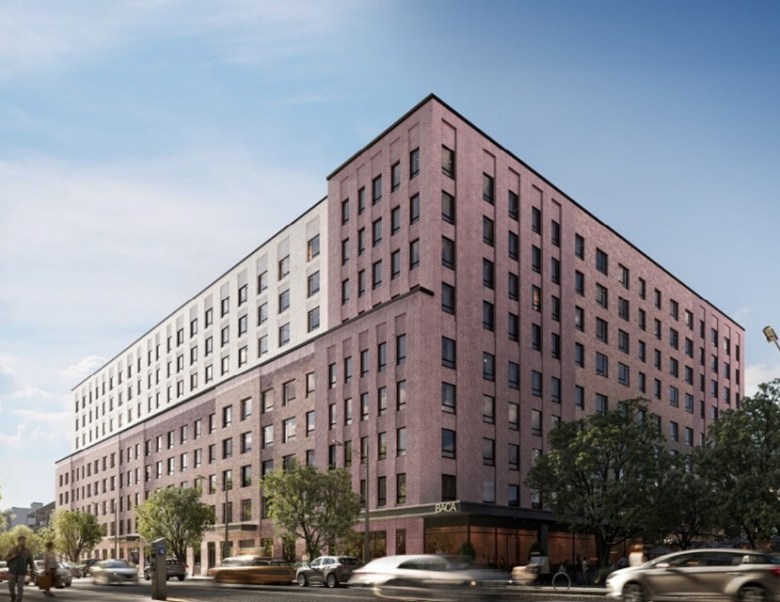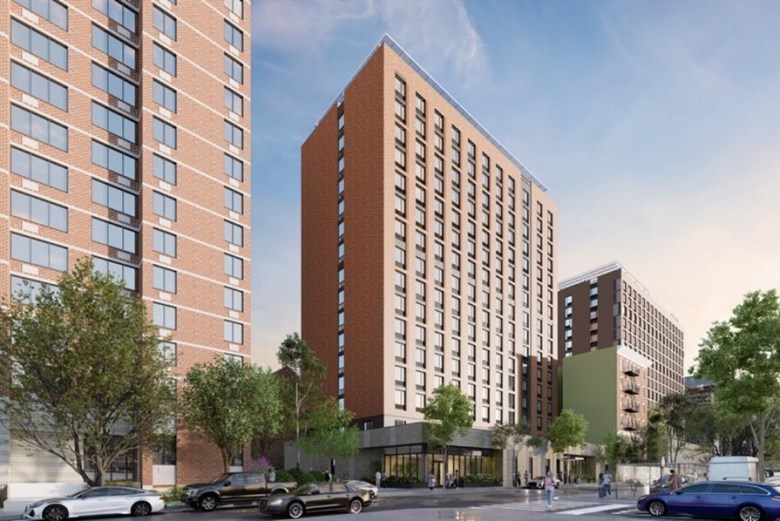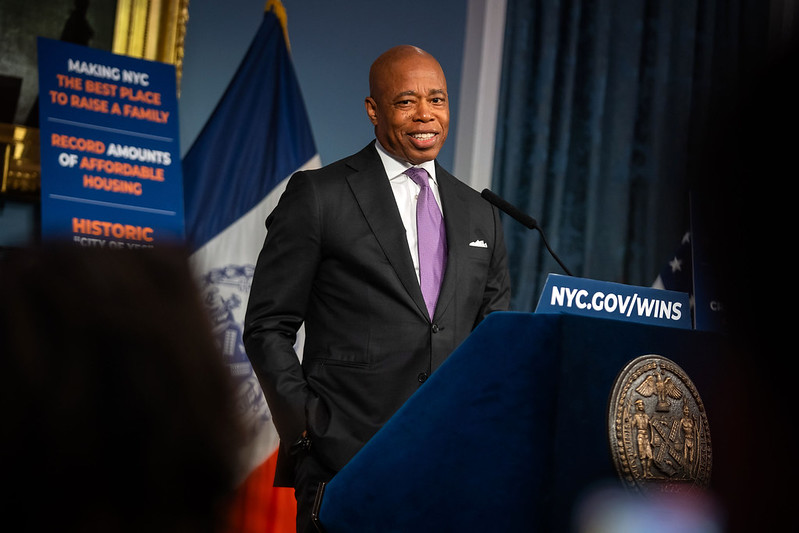Let Mayor Eric Adams tell it, and he would say he is the proud poster boy for building more housing across the city. In an op-ed he wrote for “Harlem World” magazine, he said he has the “most pro-housing administration in city history.”
Adams’s City of Yes for Housing Opportunity (CHO) plan, an overhaul of the city’s zoning rules to allow for more housing in every City Council district, was approved in 2024. The goal of the plan is to build 500,000 homes by 2032. As a complement to the mayor’s plan, the City Council also passed City for All to deepen commitments to preserving affordable housing and homeownership.
“When our administration came into office, we were clear that our city could not afford to keep kicking the can down the road on housing; it was not enough to tinker around the edges of our housing crisis,” wrote Adams, who is seeking a second term in office, “and we could not pass the buck off to a future administration.”
A number of housing developments have received Adams’s stamp of approval recently.
Adams announced the Ridge Street Apartments, a 16-story building for seniors on Manhattan’s Lower East Side. The building is part of the city’s Senior Affordable Rental Apartments (SARA) program, offering 190 studio and one-bedroom apartments for low-income seniors age 62 and older at or below 50% of the area median income (AMI). The project is expected to cost $176 million, with the Adams administration contributing $32 million. Construction is expected to begin later this year and be completed by 2028, according to the city.
“We passed the first citywide zoning reform in 60 years to build a little more housing in every neighborhood and advanced five ambitious neighborhood plans to scrap outdated zoning in neighborhoods like Jamaica and Bronx Metro North,” Adams continued. “Because of these historic efforts, we are proud to call ourselves the most pro-housing administration in city history.”
More examples of the city’s efforts include breaking ground on the Innovative Urban Village housing development in East New York, Brooklyn, on July 15. The multi-phase redevelopment project spans 11 buildings over several acres of land. The campus will belong to the Christian Cultural Center, which promises to create 385 affordable and supportive units at up to 80% of the AMI in the first phase. Another 94 apartments are reserved for households in need of support services such as case management, legal advice, and nutritional support.
 Brownsville, Brooklyn. (Photo credit: Aufgang Architects)
Brownsville, Brooklyn. (Photo credit: Aufgang Architects)
 Ridge Street Apartments will deliver 190 truly affordable homes for
Ridge Street Apartments will deliver 190 truly affordable homes for
seniors on Lower East Side. (Photo credit: Handel Architects LLP)
A second phase includes two buildings that aim to build 453 income-based affordable rental units. The city’s Department of Housing Preservation and Development (HPD) allocated $47 million for the site, reserving it for its “extremely … low-income affordability program.”
The Brownsville Arts Center & Apartments (BACA) project aims to build 283 affordable rental apartments, at between 30% and 70% of the AMI, as well as a 28,000-square-foot cultural arts center on a city-owned site in Brooklyn. The project is expected to cost $254 million, with the mayor’s office contributing nearly $100 million in city subsidies.
Finally, the city has also approved plans to reshape central corridors in heavily trafficked neighborhoods like the Bronx-Metro North Station Area plan for uptown and the Bronx; the Atlantic Avenue Mixed-Use plan in Brooklyn; a plan to convert vacant offices into housing in Manhattan; and in Queens, the Jamaica Now Neighborhood Action plan and the OneLIC Neighborhood revamp of Long Island City’s waterfront.
“Study after study validates the impact of increased housing production in slowing the pace of rent growth,” said a Real Estate Board of New York (REBNY) spokesperson. “A wide range of elected officials now advocate(s) for reforms to accelerate housing production and should be commended for adopting data-driven policy over NIMBYism.”
New York University’s (NYU) Furman Center’s Supply Skepticism Revisited study from 2023 found that increasing housing supply reduces or slows growth in rentals in the region, according to REBNY.
Many agree that more housing is part of the solution to the city’s housing and affordability crisis, but there is concern that the push to build will ultimately harm historically Black and Brown or low-income communities being built in.
“The Adams Administration’s commitment to building more housing, catalyzed by ‘City of Yes,’ is certainly commendable and should be celebrated. In the most simple terms, increasing the housing supply stands to benefit all New Yorkers,” said Christine C. Quinn, president and CEO of Win (formerly Women in Need), in a statement. “However, to truly be pro-housing, that housing must be affordable and accessible.”
The issue of preventing current tenants and homeowners from fleeing the city due to gentrification or high rents while new housing is being built is still present. It is an area where Adams has met criticism.
“The Adams Administration’s recently proposed rent hike on CityFHEPS recipients runs counter to that mission and will make housing harder to access for hundreds of hardworking families across our city,” added Quinn. “The Administration has an opportunity to truly lead on housing, but only if they reverse course on shortsighted policies like the CityFHEPS rent hike and begin to prioritize affordability and accessibility in policymaking.”
On June 30, the city’s Rent Guidelines Board (RGB) voted to raise rents by 3% on a one-year lease and 4.5% on a two-year lease. This was the fourth year in a row that rents were increased for 2.4 million rent-stabilized New Yorkers, for a total of 12% while Adams has been in office, said housing advocates. Although the RGB is an independent body, they criticized RGB board members appointed by Adams.
Assemblymember Zohran Mamdani, the Democratic nominee challenging Adams in November’s general election, has also slammed the mayor over the latest rent hike and has been especially vocal about implementing a rent freeze for rent-stabilized apartments during his campaign.
Kai Cogsville, communications director for the New York Interfaith Commission for Housing Equality and founder of Defend Harlem, which spent much energy on protesting the One45 housing development in Harlem recently approved by the City Council, said that he “doesn’t necessarily think pro-housing is good or bad.” He does believe that any housing built should prioritize being affordable for essential, working-class households with incomes from $30,000 to $60,000. “Those are the folks being priced out. They need to build for those folks,” said Cogsville.
Cogsville’s father, Donald Cogsville, was president and a founding member of the Harlem Urban Development Corporation (HUDC) in 1995. The HUDC was dissolved by former Gov. George Pataki in favor of a state-controlled agency. Cogsville believes that recreating the HUDC with affordable housing entities funded by the state could be a solution to the city’s housing crisis.
Adams is set to launch a City of Yes for Families plan this year, which is a set of zoning proposals and housing initiatives meant to help families stay in the city, such as co-located housing and schools, more grocery stores, the Privately Owned Public Spaces (POPS) program to encourage the creation of more playgrounds, and better public transit stations.
Like this:
Like Loading…
Related
